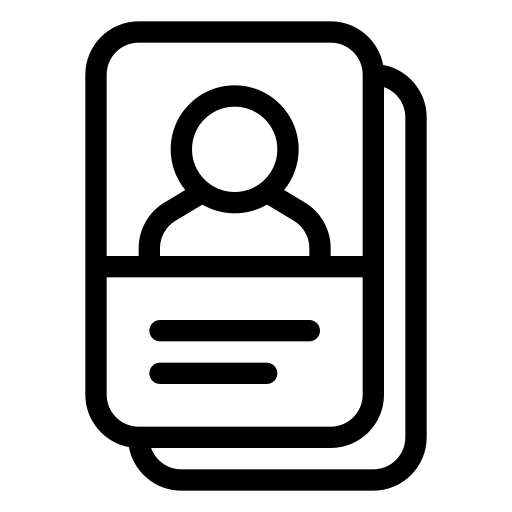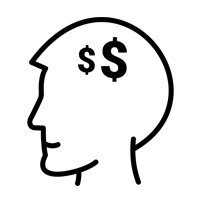Proscriptive Norms
The Basic Idea
As a child, how many times did your parents tell you not to do something? “No pulling my hair!”, “You can’t touch the cookie jar!”, “Don’t put your fingers so close to that socket!” But being a kid, you probably still tried to sneak a cookie when no one else was around.
As adults, we are still governed by these rules, though we typically adhere to them a little more. Think of the laws that tell us not to litter or blast music after 10 p.m. Religious moral codes are also based on this form of rule, such as the ten commandments: Thou shall not murder and thou shall not steal.1 Whether it be the ten commandments or local bylaws, most of us follow these rules.
These “dont’s” that society has established are called proscriptive norms. They ask us to avoid or abstain from bad behaviours, usually to avoid negative consequences.2 Proscriptive norms can best be explained when contrasted with prescriptive norms. Prescriptive norms are the “dos”: the good behaviours that society expects from us due to their positive impact.2
Proscriptive norms are often harsher and have drastic consequences when not followed.2 Stealing, for instance, has greater ramifications than giving money to someone in need. Consequently, proscriptive norms are mandatory, while prescriptive norms are more flexible.2
Social inclusion is absolutely central to human morality, commonly cast in terms of how we should or should not behave in order to be valued members of society.
– Frans de Waal, Primatologist and author of Good Natured: The Origins of Right and Wrong in Humans and Other Animals.
Theory, meet practice
TDL is an applied research consultancy. In our work, we leverage the insights of diverse fields—from psychology and economics to machine learning and behavioral data science—to sculpt targeted solutions to nuanced problems.
Key Terms
Approach Orientation: When an individual is motivated by a positive end-goal, and engages in behaviours to arrive at it. It entails the activation of certain goal-oriented behaviours.2 For instance, a child might work hard and study to achieve good grades.
Avoidance Orientation: This occurs when an individual is motivated by a negative end-goal, meaning they want to avoid an undesirable result of their actions. This entails an inhibition of certain behaviours.2 For example, a child might inhibit their desire to secretly eat cookies to avoid their parent’s anger.
Negativity Bias: The human tendency to give greater importance to negative outcomes of an event over the positive ones. For instance, if a person loses $50, it hurts more than winning $50 feels good. This bias is encapsulated by the popular phrase “losses loom larger than gains.”2.
Reactance Theory: Psychological reactance occurs when individuals feel that their freedom to engage in certain behaviours is being threatened, they feel inclined to engage in behaviours opposite to those being advised to regain this freedom.9 For example, a chain smoker who is told not to smoke may actually smoke more.
History
In 2009, Ronnie Janoff-Bulman, Sana Sheikh, and Sebastian Hepp published a cornerstone study comparing the prescriptive/proscriptive norm system to the approach/avoidance systems in motivation psychology. As the name suggests, a person with an approach orientation has a positive end-goal, which triggers the behavioural activation system (BAS), which activates certain behaviours to accomplish the desired goal. On the other hand, avoidance orientation is related to a negative end-goal, triggering the behavioural inhibition system (BIS) which leads to certain behaviours being inhibited to prevent a negative outcome. The researchers discovered that prescriptive norms mirror an approach-based orientation system, while proscriptive norms reflect the avoidance system.2
Previous research on the approach-avoidance system has shown that there is greater power in negative outcomes. In general, negative events have larger effects on people than positive outcomes; a person would experience more disappointment if their phone was stolen, than excitement when getting a new one. Negative situations have a larger impact on us than positive events. In Shaun Nichols’ 2002 paper, he suggests norms that prohibit behaviours in order to avoid negative outcomes are more likely to be remembered.3 This is because negative outcomes are generally unpleasant – there is more harm in ignoring them.3
As a result, there is a “negativity bias” among humans.2 Generalized by the saying “losses loom larger than gains,” this bias results in us feeling worse when we lose something, rather than good when we gain something, even if the loss equals the gain. For instance, if you lost $50 at a slot machine, the negative impact of that would be more than the positive impact of winning $50.
Comparing prescriptive/proscriptive norms to the approach/avoidance system allowed Bulman, Sheikh and Hepp to correctly postulate that, in accordance with the negativity bias, proscriptive norms are harsher than prescriptive norms.2 This results in a moral asymmetry: proscriptive norms, being stricter and condemnatory, are more mandatory. We blame others for not following prospective norms more than we blame them for not fulfilling prescriptive norms.2 This finding has been crucial in subsequent research and applications of proscriptive norms, as it has helped us answer important questions like why people deviate from certain rules, indulge in harmful behaviours, and how reframing norms can help solve these problems.
Consequences
Many studies have examined the relationship between proscriptive norms and defiant behaviour, with most of them examining alcoholism. In a 1962 study, researchers Ephraim H. Mizruchi and Robert Perrucci compared deviant alcohol behaviours in certain religious groups. They found that deviant behaviour was seen as more threatening to the group when norms violated were proscriptive rather than prescriptive.4 Reactions of different groups to deviant behaviour, hence, differ according to how norms are framed in that group. Deviations from proscriptive norms are normally met with extreme reactions from the group. Interestingly, proscriptive environments have been found to foster more chronic alcoholism than prescriptive ones.5 Another study showed that 47% of the alcoholics who perceived their environment to be proscriptive identified family to be a source of these “don’ts,” while 45.5% identified the church as their moral arbiter.5 This information suggests that it is important to work with families and churches when rehabilitation centers are designing programs for chronic alcoholics.
Scholars have also studied the effectiveness of these norms amongst children. Kochanska and colleagues found that, at all ages, children were more likely to comply with a “don’t” request, rather than a “do” request. It is more likely children will listen to requests about not playing with an exciting toy over demands to clean it up.6 There was also a positive association between fearfulness and compliance with a “don’t” request, consistent with other work on fear and the behavioural inhibition system.6 This suggests that fear of the negative outcome is what prevents children, possibly even adults, from breaking proscriptive norms. Other research suggests that transgressions from proscriptive norms generate more shame, a more painful emotion, while prescriptive norms generate guilt.7
In 2014, Hibbins and colleagues found that people who were politically conservative were more inclined to the negativity bias,8 even accounting for other variables, such as sociodemographic factors. It is possible that proscriptive norms are associated with conservatism, though further research is needed to prove this assertion.
Controversies
Although there has been a lot of research on morals, norms, and the negativity bias, there is limited research on proscriptive norms themselves. Several of the consequences identified above are derivations from proscriptive norms, which only suggest possibilities of how proscriptive norms may function in decision making. The foundational research on proscriptive norms, such as the 2009 Janoff-Bulman and colleagues’ study, is poorly followed up. More direct research is required to arrive at conclusive information on the nature and application of these norms.
Case Studies
Public Health Policy and Proscriptive Norms
Alcohol consumption, as mentioned before, is influenced differently by proscriptive and prescriptive norms. The way policy makers frame health advice may elicit different behavioural responses. Since humans have a negativity bias and proscriptive norms are harsher, it may be possible that using proscriptive norms is more effective in lowering alcohol consumption.9 However, according to the reactance theory, people may feel that certain rules impede on their freedom, thereby indulging in the negative behaviour more.9
In 2018, Pavey, Sparks and Churchill conducted a study to determine whether proscriptive or prescriptive messaging is more successful in eliciting a desired behaviour. Participants were exposed to two conditions, each representing one of the norm conditions. In the prescriptive condition, they were told: “Imagine you went to the doctor, who said you should drink within government recommended safe limits for alcohol consumption. The doctor gives you no further information.”9 In the proscriptive condition, they were told: “Imagine you went to the doctor, who said you should not drink in excess of government recommended safe limits for alcohol consumption. The doctor gives you no further information.”9 The results showed that proscriptive norms were more effective in eliciting moral norms of alcohol consumption, especially for females and those who had always consumed within limits. Using proscriptive messaging reminded them of their moral obligations, and they believed that not drinking in excess aligned with their own morals and ethics.9
Another key finding was that male participants who already drank more than the recommended limits consumed more alcohol after being told about the proscriptive norm.9 Although there was no conclusive reason, it was hypothesized that this resistance was caused by reactance theory. Because the message targeted behaviours these participants usually indulged in, they may have felt that it was threatening their freedom. As a result, this intervention may have caused the opposite reaction than intended.9
Managerial Decision Making and Proscriptive Norms
Business managers are expected to perform two main tasks: contribute to society and avoid harming society.10 Noval and Stahl analyzed how managers’ moods can influence their proscriptive and prescriptive morality while making decisions.
Based on previous studies related to ethical decision making, mood research, and contextual influences, the researchers came up with four mood-related propositions:
- Positive moods lead to underestimating negative outcomes. Managers in positive moods may make harmful decisions. They engage in proscriptive immorality.
- At the same time, positive moods also influence managers to make more socially responsible decisions because they overestimate positive outcomes of an act. They engage in prescriptive morality.
- Negative moods may influence individuals to overestimate the negative effects of an act. Managers in negative moods tend to inhibit harmful acts. They engage in proscriptive morality.
- At the same time, negative moods may result in underestimating a decision’s positive effects. Managers may inhibit prosocial acts, thus engaging in prescriptive immorality.10
Put together, these propositions suggest that managers’ moods can have a large and asymmetrical influence on their decision-making, especially in ambiguous situations where decision paths are unclear.10 Positive moods may lead to engagement in prescriptive norms, but simultaneously may increase propensity to engage in proscriptive norms, thereby causing managers to perform acts they should not. Contrarily, negative moods may inhibit proscriptive morality, but also inhibit prescriptive morality.10
Ideally, this research can help managers foster a heightened awareness of their own decision-making processes, allowing them to make better decisions and respect the important do’s and don’ts set forth by society.
Related TDL Content
Why Do We Follow The Behaviour of Others?
What exactly are social norms? Why are they important? How do they impact our daily lives? Learn more about how proscriptive norms fit into the context of social norms at large.
Harnessing Social Norms for Social Good
How can social norms be used for positive impact? In this article, Paul Deutchman, PhD candidate of Psychology at Boston university, discusses social norms in a tangible manner, within the context of the COVID-19 pandemic.
Why is the News Always so Depressing?
The negativity bias influences several aspects of our life, apart from our morality. This article offers detailed insight into this bias – why it happens, how it happens, and how it is manifested in our everyday lives.
Sources
- Britannica, T. Editors of Encyclopaedia (2020, November 20). Ten Commandments. Encyclopedia Britannica. https://www.britannica.com/topic/Ten-Commandments.
- Janoff-Bulman, R., Sheikh, S., & Hepp, S. (2009). Proscriptive versus prescriptive morality: Two faces of moral regulation. Journal of personality and social psychology, 96(3), 521.
- Nichols, S. (2002). On the genealogy of norms: A case for the role of emotion in cultural evolution. Philosophy of Science, 69(2), 234-255.
- Mizruchi, E. H., & Perrucci, R. (1962). Norm qualities and differential effects of deviant behavior: An exploratory analysis. American Sociological Review, 391-399.
- Lafferty, N. A., Holden, J. M. C., & Klein, H. E. (1980). Norm qualities and alcoholism. International Journal of Social Psychiatry, 26(3), 159-165.
- Kochanska, G., Coy, K. C., & Murray, K. T. (2001). The development of self‐regulation in the first four years of life. Child development, 72(4), 1091-1111.
- Sheikh, S., & Janoff-Bulman, R. (2010). The “shoulds” and “should nots” of moral emotions: A self-regulatory perspective on shame and guilt. Personality and Social Psychology Bulletin, 36(2), 213-224.
- Hibbing, J. R., Smith, K. B., & Alford, J. R. (2014). Differences in negativity bias underlie variations in political ideology. Behavioral and brain sciences, 37, 297-307.
- Pavey, L., Sparks, P., & Churchill, S. (2018). Proscriptive vs. prescriptive health recommendations to drink alcohol within recommended limits: Effects on moral norms, reactance, attitudes, intentions and behaviour change. Alcohol and alcoholism, 53(3), 344-349.
- Noval, L. J., & Stahl, G. K. (2017). Accounting for proscriptive and prescriptive morality in the workplace: The double-edged sword effect of mood on managerial ethical decision making. Journal of Business Ethics, 142(3), 589-602.



